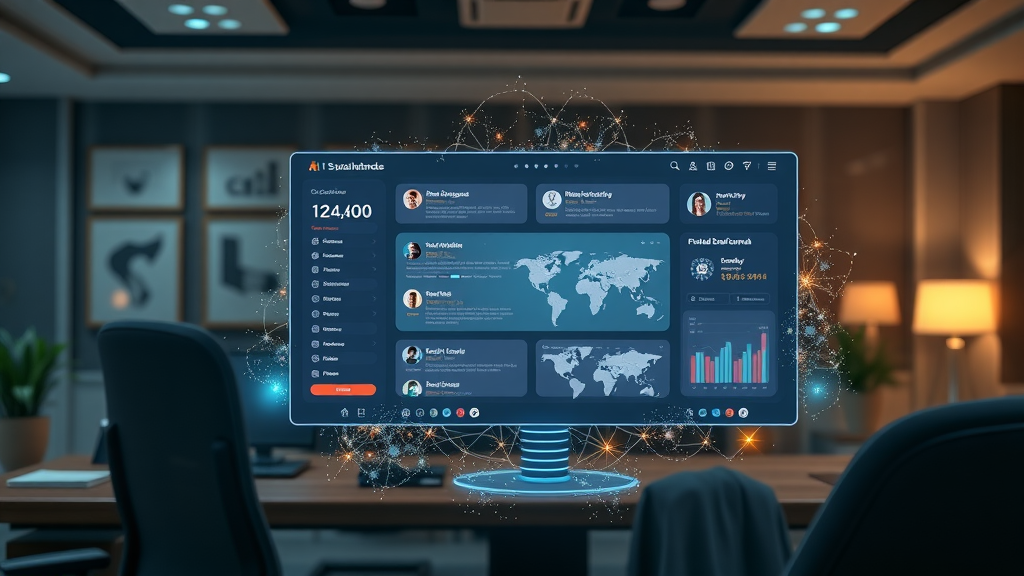Imagine losing nearly a third of your annual revenue simply because of missed or delayed responses to your customers. It’s a startling reality: in property services, every unanswered message can mean a lost opportunity, damaged reputation, or eroded trust. As communication channels continue to multiply—phone calls, emails, live chat, social media—business owners and managers in property services face a daily battle to keep up. But with artificial intelligence (AI), a new era of streamlined, effective customer communication is here, making it possible to centralise, summarise, and respond efficiently to every customer interaction. This guide shows you how to ensure you never miss a vital message again—and stay ahead in a competitive property market.
Startling Facts: The Reality of Customer Communications in Property Services

Customer communications in property services aren’t just about sending and receiving messages—they underpin every customer relationship, drive customer satisfaction, and shape your business’s reputation in the local community. Yet, the challenges are real: Businesses lose up to 30% in annual revenue due to missed or delayed customer communications. With tenants and property owners demanding faster, more personal customer service, having scattered messages across multiple channels can result in overlooked requests, late responses, and missed maintenance emergencies.
"Businesses lose up to 30% in annual revenue due to missed or delayed customer communications." – Industry Statistic
The Cost of Missed Customer Communication in Property Services
Missed or delayed responses cost property services more than just money—they risk upsetting tenants, losing landlords, and harming your reputation. Each ignored live chat or unreturned phone call sends the message that customers don’t matter, making it tough to rebuild trust. Prompt communication, on the other hand, helps customers feel valued, directly influences customer satisfaction, and can even drive customer loyalty in a highly competitive market. Businesses that resolve issues quickly and make every customer feel heard often see repeat business and positive referrals through social media and word-of-mouth.
Customer Experience and the Impact of Disconnected Communication Channels
When property services juggle emails, phone calls, and social media through separate, unlinked systems, customer experience suffers. Customers expect smooth, joined-up communication no matter which communication channel they use. Fragmentation breeds errors, duplicates effort, and leaves customer support agents scrambling to find the latest updates on customer inquiries. This confusion can cause delays in issue resolution and erode every customer relationship. AI-powered customer communications management breaks down these silos, making it possible to deliver fast, consistent, and personal responses, building a foundation of trust with every interaction.
What You'll Learn About Customer Communications Management
- What customer communications means and why it’s vital for property services
- Different channels and types of customer communication
- How AI is redefining customer communication management
- Key AI tools for centralizing and summarizing messages
- Implementing best practices in customer communications management to boost customer satisfaction and loyalty
- FAQs about customer communications
Understanding Customer Communications: A Modern Overview

What Do You Mean by Customer Communication?
Customer communication refers to all the ways you interact with your customers—whether it’s through emails, phone calls, live chat, social media posts, or knowledge base updates. For property services, this means not only answering questions about rent, repairs, or appointments, but also creating ongoing connections that foster customer loyalty. Effective customer communication builds strong customer relationships, supports customer engagement, and ensures every customer inquiry is addressed promptly—making customers feel respected and heard in every interaction.
People Also Ask: What do you mean by customer communication?
Customer communication refers to all channels and methods through which businesses and customers interact, ranging from emails and live chats to phone calls and social media exchanges. In property services, maintaining productive customer communications is pivotal for customer engagement and relationship management.
Types of Customer Communication
People Also Ask: What are the types of customer communication?
There are several types of customer communication, each crucial for delivering excellent customer service and boosting customer satisfaction. Proactive communication includes reminders about appointments, rent, or maintenance. Reactive communication is when you respond to tenant questions, complaints, or emergencies. Transactional messages confirm bookings or payments. Property services firms use multiple communication channels—like live chat on websites, emails for detailed documentation, phone calls for urgent support, and social media for public engagement. Integrating these channels ensures no inquiry slips through the cracks and helps maintain consistent service quality.

The Importance of Customer Communications Management
Strong customer communications management (CCM) guarantees every message is tracked, answered, and stored—regardless of where it comes from. In property services, CCM is the backbone for operational efficiency and outstanding customer experience. Effective communications management makes customers feel valued, lays a groundwork for customer loyalty, and promotes seamless collaboration across teams.
Exploring Customer Communications Management (CCM): Essentials for Property Services
What Does CCM Mean in Banking?
People Also Ask: What does CCM mean in banking?
In both banking and property services, Customer Communications Management (CCM) describes robust, automated systems for handling high volumes of personalised communications. These solutions ensure compliance, clarity, and positive customer experience across all touchpoints—email, live chat, phone call, and social media. For property managers, adopting CCM means your team can communicate with customers with ease, keep detailed records, and resolve issues faster, all while safeguarding customer data and privacy.
Core Objectives of Effective Customer Communication
The main aims of customer communication management are: providing accurate, timely information; enhancing customer engagement; accelerating response times; and ensuring compliance with data privacy standards. By centralising customer communications, property managers can make informed decisions, streamline workflows, and make every customer feel important, efficiently turning inquiries into positive customer experiences and long-term relationships.
Customer Communication Management in Property Services: Unique Challenges
Property services face unique hurdles—urgent maintenance requests coming via phone call, onboarding tenants via live chat, or managing reviews on social media. Ensuring no message is missed requires a coordinated communication strategy. Multiple channels can make it hard to follow customer journeys, creating delays or double-handling. Advanced CCM tools address these by centralising conversations and allowing teams to monitor, analyse, and act quickly on every customer interaction.
Analyzing Communication Channels: Where Customer Communications Happen Today

Key Communication Channels for Property Services
- Phone calls: Handling queries and emergencies
- Live chat: Real-time website support
- Emails: Detailed follow-ups and documentation
- Social media: Public engagement and review management
- Knowledge base/self-service portals
Integrating Omnichannel Communication Management Systems
Customers today expect to interact with property services across multiple channels seamlessly. Whether a tenant starts an inquiry through a live chat, follows up via email, and then references their case on a phone call, every step should be unified. Modern customer communications strategies demand a single platform that centralises all these interactions. Here’s how AI can enhance each communication channel for property services:
| Channel | Typical Use | AI Integration Potential |
|---|---|---|
| Phone Call | Urgent repairs/maintenance | Call transcriptions and summaries |
| Live Chat | Tenant onboarding/support | Chatbots and conversation analysis |
| Rent reminders, invoices | Automated replies, sorting, summarization | |
| Social Media | Community engagement | Sentiment analysis, review monitoring |
AI in Customer Communications: Centralizing and Summarizing Interactions

How AI Transforms Customer Communication Management
AI is transforming the way property services manage customer communications. Advanced AI systems instantly centralize messages from multiple channels into one easy-to-use inbox. AI-powered tools can summarise hundreds of customer interactions in seconds, highlight urgent requests, and even suggest best responses based on previous resolutions. By automating routine tasks, AI empowers human staff to focus on meaningful connections—driving improved customer engagement, efficient communication management, and reduced risk of missed messages or dissatisfied customers.
Centralized Platforms for Property Services: Streamlining Communication Channels
Centralized platforms powered by AI have become the backbone of modern communications management in property services. These systems unify live chat, email, phone call records, and social media interactions, giving staff a 360° view of every customer. This helps resolve issues faster, tracks communication history, and allows every team member to provide personalised responses even if multiple agents are involved over time. Such platforms help maintain a consistent communication strategy and ensure every customer feels like a priority.
Summarization and Prioritization of Customer Communications with AI
One of AI’s biggest advantages is its ability to instantly summarize long email threads, live chat exchanges, and phone transcripts. Instead of sifting through hundreds of messages, staff can review concise summaries highlighting key points, priorities, and urgent actions. AI can “triage” incoming messages, assign them based on priority or topic, and flag escalations for swift follow-up. This ensures no critical customer support request is overlooked and helps maintain high standards of customer satisfaction within property services.
Watch an animated walkthrough of a property manager using a smart platform to integrate, summarize, and act on messages from multiple channels—resulting in improved customer satisfaction statistics on screen.
Selecting the Right AI Tools for Customer Communications Management
Leading AI Solutions for Property Services Customer Communication
- AI-driven CRM and CCM tools: Manage customer data, track inquiries, and automate message flows
- Smart inboxes for unified communications management: Collect messages from all channels in one dashboard
- AI-powered chatbots for live chat and social media: Offer instant support, answer FAQs, and escalate urgent issues
- Speech and text analytics for phone call summaries: Transcribe calls, highlight key concerns, and summarise conversations

Integrating AI Tools: Challenges and Solutions
Integrating AI into customer communications management may come with hurdles like legacy software compatibility, data migration, and training staff. To overcome these, start with a clear roadmap: choose tools that offer robust support, ensure seamless data transfers, and provide ongoing training. Work closely with AI solution providers to ensure your system grows with your business and meets local compliance standards, especially for sensitive customer data and communications management.
Implementation Roadmap for AI Customer Communication Management
1. Audit current systems. List all communication channels, processes, and pain points.
2. Select an AI platform with proven CCM features for property services.
3. Integrate existing channels and migrate data (emails, live chat records, phone transcripts, social media) to your new platform.
4. Train your team to use AI-powered summaries and prioritisation.
5. Review performance regularly using new analytics.
Following this roadmap ensures you deliver seamless customer support and consistently resolve issues across multiple channels.
Watch a step-by-step demo showing a property services business setting up and using an AI-powered communication management platform.
Best Practices for Customer Communications in Property Services

Communication Strategy for Customer Satisfaction
Building a strong communication strategy is critical for delivering excellent customer service in property services. Start by identifying the most-used communication channels among your customers and ensure consistent, fast responses on each. Personalise interactions where possible, keep messages clear and friendly, and resolve issues without delay. Regularly gather customer feedback and adapt your communication strategies to emerging trends, such as expanding your presence on social media or adding new self-service knowledge base content for customer support.
Staff Training and Change Management
Transitioning to AI-driven customer communications management requires thoughtful change management. Train your team on the new platform, emphasizing its benefits for both staff and customers. Highlight that AI doesn’t replace human service—it enhances staff abilities and helps them prioritise what matters most. Continuous learning sessions and open channels for staff feedback make change adoption smoother, reducing anxiety and boosting team morale.
Data Security, Compliance, and Ethical Use of AI
With increased use of AI, safeguarding customer data is more important than ever. Ensure your systems comply with UK data protection standards, and educate staff on the ethical use of AI—avoiding bias in automation, maintaining transparency in customer interactions, and keeping sensitive information secure. Always give customers clear information about how their data is used within your communication management workflow.
Maintaining Personal Touch Amidst Automation
Automation is a huge advantage, but property services thrive on a personal touch. Make sure routine customer inquiries are handled quickly by AI, but leave space for human interaction on complex or sensitive issues. Train your staff to step in when customers need extra care, and use customer data insights to address customers by name or reference their history. This balance helps build loyalty and sets your service apart—even in a digital-first world.
View a real-life case study of a property management firm boosting customer loyalty using AI tools to personalize and accelerate all customer interactions.
Measuring Success: Metrics for Customer Communication Management

Customer Experience and Feedback Collection
Measuring customer experience is essential for continuous improvement. Collect customer feedback through surveys, online reviews, and post-interaction ratings on live chat or email. Track patterns to spot areas for service enhancement. Analysing this customer data helps focus staff training, discover communication channel preferences, and ensure every customer interaction contributes to positive experiences and loyalty.
Key Performance Indicators for Communication Management
Use these KPIs to monitor the success of your customer communications strategy:
| Metric | Description | AI Enhancement |
|---|---|---|
| First Response Time | Average time to first reply | AI auto-replies |
| Message Resolution Rate | Percentage resolved within 24h | AI triage and routing |
| Customer Satisfaction (CSAT) | Survey-based measure | AI sentiment analysis |
| Channel Utilization | Distribution of channel usage | Channel recommendations |
FAQs: Everything You Need to Know About Customer Communications in Property Services
-
How do AI tools protect sensitive customer communications?
AI platforms use advanced encryption and multi-factor authentication to protect customer data from unauthorised access or loss. Access is tightly controlled, ensuring only relevant staff can view private messages or personal information, keeping trust paramount in every customer interaction. -
Can AI effectively handle non-English customer communications?
Modern AI communication tools support multiple languages, translating live chat, emails, or even phone call transcripts in real time. This lets you communicate with every customer, regardless of their preferred language, strengthening inclusivity and customer satisfaction. -
What are typical costs for AI customer communications management platforms?
Prices vary widely—from low-cost monthly subscriptions for SMEs to enterprise-level systems with bespoke features. Most providers charge per user, per month. Always factor in setup, integration, and training expenses in your budget. -
What role does AI play in customer loyalty in property services?
AI enables faster responses, consistent service, and personalised engagement. By resolving inquiries quickly and accurately, AI tools help foster trust and loyalty, keeping tenants and landlords satisfied and likely to return or recommend your business. -
Is manual oversight still needed with AI-driven customer communication management?
Yes—while AI automates routine tasks, human oversight is vital for complex queries, emotional intelligence, and maintaining high service standards. Blending AI with hands-on customer service ensures every experience is positive and genuine.
People Also Ask: Key Questions on Customer Communications
What Are the 5 C's of Customer Service?
People Also Ask: What are the 5 C's of customer service?
The 5 C's are Communication, Consistency, Convenience, Competence, and Courtesy—essential values for delivering top customer service and effective communication in property management. Focusing on these principles strengthens every customer interaction and drives lasting loyalty.
Key Takeaways: Mastering Customer Communications with AI
- Centralize all your customer communications for consistent service quality.
- Leverage AI to summarise, analyse, and prioritise queries across all communication channels.
- Embrace best practices to maintain a personal touch while reaping automation benefits.
- Invest in continuous improvement based on customer data analytics and feedback.
Conclusion: Never Miss a Customer Message Again
In an era of increasing competition and rising expectations, effective customer communications and smart management tools distinguish thriving property services businesses. Introducing AI into your communication strategy is no longer optional—it's essential for delivering seamless, efficient, and personalised customer experience.
"Staying on top of every message isn’t just about technology—it’s about building trust, loyalty, and lasting customer relationships."
Discover more about putting AI to work in your business – contact us at AI@dylbo.com
To enhance your understanding of effective customer communication strategies, consider exploring the following resources:
-
“Customer communications: In-depth guide for modern businesses”: This comprehensive guide delves into various communication channels, including live chat, SMS, and social media, offering insights on how businesses can leverage these platforms to improve customer interactions. (aircall.io)
-
“12 Ways to Improve Customer Communication”: This article provides practical tips on personalizing communications, meeting customers on their preferred channels, and utilizing templates and automation to streamline interactions. (waypathconsulting.com)
By integrating the strategies and insights from these resources, you can develop a more effective and personalized customer communication approach, ultimately enhancing customer satisfaction and loyalty.
 Add Row
Add Row  Add
Add 










Write A Comment